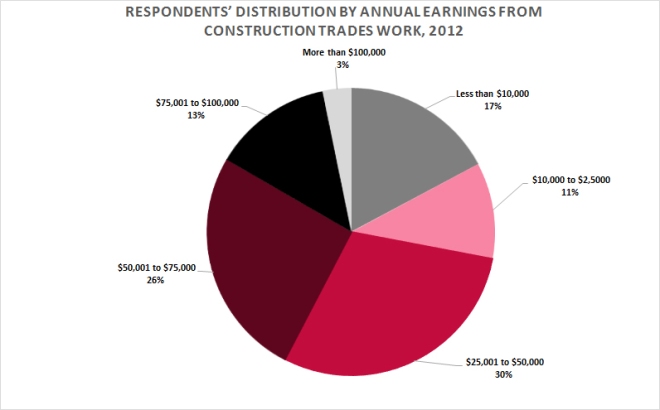During the past 40 years, many previously male-dominated occupations have become integrated, but women’s share of construction trades jobs has remained below five percent. Despite this, because the construction industry is so large, more women work in the construction trades than work as dental hygienists, pharmacists, or veterinarians. As the construction industry continues to add jobs in the recovery following the Great Recession, and as the U.S. Bureau of Labor Statistics predicts that construction occupations will see above average employment growth in the coming years, the question of how to unblock the construction industry for women is once again on the agenda and gaining interest: a recent webinar on women in construction hosted by the Women’s Bureau of the U.S. Department of Labor attracted close to 1,000 registrants.
Two new IWPR publications provide insights into women’s experiences working in construction and offer suggestions for how to reduce barriers to entry. An IWPR Research-in-Brief, Women in Construction and the Economic Recovery: Results from the 2013 IWPR Tradeswomen Survey, presents results from an exploratory survey conducted in the spring of 2013. The survey, which includes responses from over 200 women working in the trades, presents a mixed picture. Over 40 percent of tradeswomen respondents earned at least $50,000 in 2012. Yet, only 27 percent had been able to work year-round and 22 percent of respondents were unemployed.
Fewer than two-thirds of respondents report equal treatment when it comes to being respected on the job, hiring and allocation of hours, and assignments. Only 42 percent report equal treatment when it comes to promotions, and 30 percent report that they are “always” or “frequently” sexually harassed. Rates of racial harassment and discrimination, discrimination based on sexual orientation, and age discrimination are even higher and, in fact, more than one in ten respondents have taken discrimination claims to the Equal Employment Opportunity Commission.
Another recent study, Untapped Resources, Untapped Labor Pool: Using Federal Highway Funds to Prepare Women for Careers in Construction, provides examples of how women’s under-representation in construction is being addressed by targeted policies and funding in Oregon and Maryland. Since 2009, Oregon has reserved part of its federal highway funding to increase diversity in the highway construction workforce. Oregon has funded child care and other retention services for construction apprentices, pre-apprenticeship training, career fairs and outreach, and supervisor training for employers on how to tackle workplace discrimination and harassment. Retention rates for women and minority male apprentices have improved significantly, and women’s share of construction apprenticeships in Oregon is twice the national rate.
To view more of IWPR’s research, visit IWPR.org

